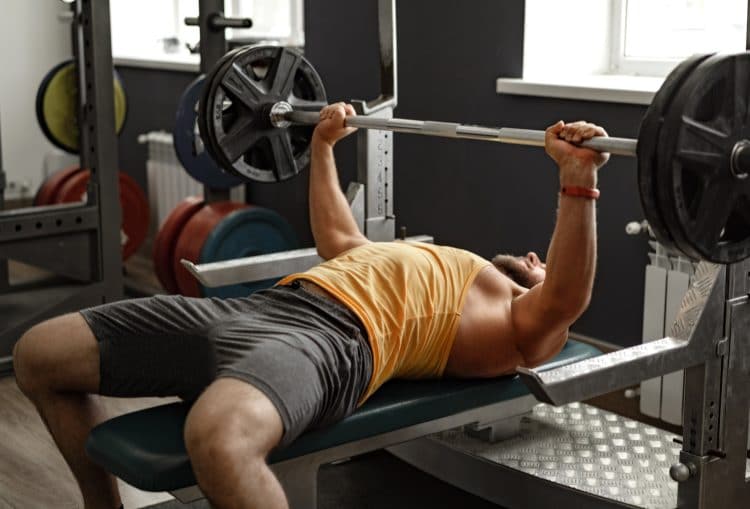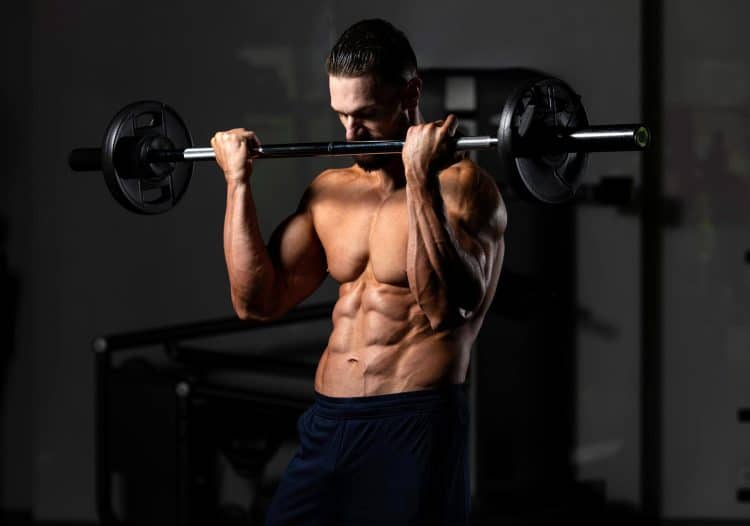Training to build strength and muscle mass isn’t easy. Creating a head-turning physique takes time, effort, and energy. You need to pay your dues in the gym, eat like it’s your job, take the right supplements, and respect your body’s need for recovery and sleep.
It’s fair to say that getting in great shape is a full-time job!
Because of this, most lifters are always on the lookout for tips and tricks to maximize their progress and get more from their workouts. After all, your time and energy are valuable resources, so it makes sense to invest them wisely and not waste them.
Things that make your workouts more productive include:
- Warming up properly
- Using an appropriate set/rep scheme
- Resting for the right amount of time between sets
- Choosing the best exercises
- Managing training frequency, intensity, and volume
- Using the best split routine
- Optimizing recovery
- Eating enough protein
But, even if you do all these things, there is still more that you can do to turn workout productivity up another couple of notches.
We’re talking about negative reps.
Level Up Your Fitness: Join our 💪 strong community in Fitness Volt Newsletter. Get daily inspiration, expert-backed workouts, nutrition tips, the latest in strength sports, and the support you need to reach your goals. Subscribe for free!
In this article, we explain what negative reps are, reveal their benefits, and tell you how best to use this powerful training strategy.
Muscle Contractions 101
To understand negative reps and how they work, you need to know a little about muscle contractions. Muscles generate force in three different ways:

Concentric muscle contractions
A concentric muscle contraction is when your muscles shorten to generate force. An example of this is the start of a deadlift or biceps curl. With concentric contractions, you start your rep from a stretched position, where the muscle is elongated. Most pulling exercises begin with a concentric contraction.
In terms of strength, concentrics are the weakest type of muscle contraction. Concentric contractions are also known as positive contractions.
Isometric muscle contractions
An isometric contraction is where a muscle generates force but does not change length. Planks are a good example of this, as are static biceps holds. Isometric contractions are powerful, and you should be able to hold very heavy loads statically.
Most exercises include a brief isometric pause at the top and bottom of each rep. You can also do isometric training to increase static strength, improve your mind-muscle connection, or as an alternative to more dynamic strength training.
Eccentric muscle contractions
Eccentric contractions are where your muscles generate tension as they lengthen. Also known as negative contractions, eccentric contractions are stronger than concentrics but not as strong as isometrics.
Examples of eccentrics include the descent in a squat, lowering your chest toward the floor during a push-up, and the lowering portion of a biceps curl. Eccentric contractions start with your muscles in a shortened position.
Read also: Eccentric Vs. Concentric training
The Benefits of Negative Reps
While most exercises involve a concentric, isometric, and eccentric phase, it is possible to emphasize or even isolate the negative portion of many movements. In fact, there are several positive benefits to emphasizing the negative.
Get stronger
Doing negative reps may make you stronger than concentric reps (1). As mentioned, you are stronger eccentrically than you are concentrically. In other words, you can lower more weight than you can lift. Doing negative reps means you can train with weights closer to your one-repetition maximum, or 1RM, which will produce greater increases in strength.
Heavier loads produce more muscle tension, stimulate your central nervous system more, and desensitize your Golgi tendon organs so you can learn to recruit more motor units and muscle fibers.
Working on your eccentric strength will transfer to increased concentric strength.

Build more muscle
Eccentric contractions, and therefore negative reps, are an essential part of the muscle-building process (1). A controlled eccentric causes microscopic muscle trauma, which is thought to be one of the drivers of muscle hypertrophy. Doing negative reps emphasizes this critical part of the contraction and, as such, they could help you build bigger muscles in less time.
Improve body composition
If you want to lose fat while building muscle, negative reps may help. Studies suggest that eccentric training causes a more significant increase in post-exercise energy expenditure than traditional concentric/eccentric reps (2). While this effect is statistically small, when it comes to getting shredded while building muscle, any advantage will be very welcome.
Increased muscular resilience
Negative reps are almost always accompanied by delayed onset muscle soreness or DOMS. DOMS typically lasts 48-72 hours after training and can be quite debilitating. However, while negative reps do cause DOMS, soreness tends to be less severe after a few workouts. This is because of something called the repeated bout effect.
While you will initially have to work through moderate to severe post-training soreness, after a couple of weeks of negative reps, you could find yourself “immunized” against DOMS so that soreness ceases to be much of a problem, no matter how hard you train (3).
A better mind-muscle connection
Lowering a potentially heavy weight under control forces you to focus on the muscles you are training. This strengthens not only the muscles themselves but your ability to control them. Bodybuilders call this the mind-muscle connection.
A stronger mind-muscle connection will make every exercise more effective. The better you can control a muscle, the more responsive it will be to training (4).
Negative Reps Drawbacks
While the effects of negative reps are largely positive, there are a couple of drawbacks to consider:
Delayed onset muscle soreness can be severe
Lowering heavy weights overloads your muscles and creates lots of muscle trauma. If you are unused to this type of training, delayed onset muscle soreness can be severe. Although it will lessen over time, this soreness can be a real problem if you plan on training again anytime soon.
The best way to minimize post-negative training DOMS is to introduce it gradually and avoid doing too much too soon.
Risk of injury
Some types of negative reps involve lowering heavy weights – potentially heavier than you can lift. This increases the strain on your muscles, tendons, ligaments, and joints, all of which are susceptible to injury.
Because of this, negative reps are best left to more experienced exercisers and are not really suitable for beginners.
Five Ways to Do Negative Reps
Now that you know the benefits of negative reps, you are probably champing at the bit to try them for yourself. There are several ways you can add negative reps to your workouts, which are outlined below!
1. Negative emphasis reps
If you are new to negative reps, this is probably the best place to start. You can use this method with almost any exercise, so it’s easy to implement and not overly stressful.
Simply lift the weight as usual, then lower it under control in 3-5 seconds. Push the weight up and repeat until your muscles are fatigued. You can use slower negatives to make them more intense, e.g., 8-10 seconds.
2. Forced reps
This method starts with reps performed in the usual fashion but ends with a few negative reps. This is an excellent way to extend your set beyond your normal point of failure. However, you will need a training partner for this method.
Level Up Your Fitness: Join our 💪 strong community in Fitness Volt Newsletter. Get daily inspiration, expert-backed workouts, nutrition tips, the latest in strength sports, and the support you need to reach your goals. Subscribe for free!
Perform your chosen exercise until you cannot continue, i.e., concentric or positive failure. At this point, your training partner will help you lift the weight, and you then lower it on your own. Do 3-5 of these forced reps to fully exhaust your muscles.
3. Two limbs up, one limb down
No spotter or training partner? No problem! You can do negative reps on your own. With this method, you simply lift a weight with two limbs and then lower it with one. You can alternate limbs or do an even number of sets per side.
This negative rep training method works well with:
4. Negative-only reps
With this negative training method, you do not lift the weight but only lower it. It can be used to train with supra-maximal loads or just with bodyweight exercises, so it’s a very versatile training method.
For supra-maximal training, load up your chosen exercise with about 10% more weight than you can typically lift. Get a training partner or two to help you raise the weight to the top of the movement and then lower it slowly and under control on your own.
Negative-only reps also work well for exercises like pull-ups and dips. Both are challenging exercises to master as you need to be strong enough to lift your entire body weight with just your arms, and it’s not always possible to make them more manageable.
Because you are stronger eccentrically than you are concentrically, you may be able to lower yourself down, even if you can’t pull or pull yourself up. Doing negative-only pull-ups and dips will help build the strength your need to eventually do full reps.
Simply climb up into the top position of a pull-up or dip and lower yourself under control. Repeat until you are no longer able to control your descent.
5. Weight releasers
Weight releasers allow you to lower more weight than you lift. They attach to a barbell and unhook at the bottom of your rep when the weight releaser touches the floor. They are adjustable, are commonly used for squats and bench presses, and are popular amongst powerlifters.
On the downside, you only get one negative overload rep per set, so they have limited value for bodybuilders and recreational lifters. Also, on occasion, the additional weight may not detach, which could cause serious injury.
Negative Reps FAQs
Do you have a burning question about negative reps? No worries; we’ve got the answers!
1. How often should I do negative reps?
Negative reps expose your muscles to more work than they are used to. This is what makes them so effective. However, this also means they take a lot out of your body and will take longer to recover from than regular sets a and reps.
With that in mind, you should probably limit your use of negatives to once per week per muscle group and only use them for a couple of exercises and sets.
Also, remember that initially, at least, negative reps will cause a lot of DOMS, which may mean you need to do them less often.
2. Are negatives suitable for long-term use?
Because negative reps are so intense, it’s probably best not to use them all the time or for long periods. Instead, use them at the end of a training block, say 2-4 weeks, before a deload. This will lead to supercompensation so that, after your break, you come back stronger.
Alternatively, you can just add them to your workout occasionally when you feel you still have energy to burn and want to finish off whatever muscles you are training.

3. Are negative reps safe?
Negative reps SHOULD be safe, providing you take a few precautions.
Firstly, remember this is an advanced workout method, so make sure you’re actually ready to do this type of training. Beginners are not usually ready for negatives, and nor do they need to do them as basic workouts should still be productive.
Next, always warm up thoroughly before doing negative reps. You are about to expose your muscles to more weight than usual, so you need to be ready for the extra load involved.
Finally, for exercises like negative bench presses, make sure you always have a competent spotter on hand. Otherwise, you could find yourself pinned under a heavy weight with no means of escape. This is how serious injuries happen.
4. Where in my workout should I put negative reps?
There is no definitive answer to this question, as negative reps can work wherever you put them in your workout.
For example, you could do heavy negatives at the start of your workout to build strength and then move on to lighter, more straightforward exercises to work on hypertrophy and endurance.
Alternatively, you could do negative reps at the end of your workout and use them as a finisher to wring the last bit of energy from your muscles.
They can also work somewhere closer to the middle of your workout if you simply want to use them to add some variation to your training program.
Ultimately, you should experiment with all the options and see which works best.
5. What exercises work best with negative reps?
You can use negative reps with almost any strength training exercise. However, some of the methods work best with specific movements. For example, the two limbs up, one limb down approach is unsuitable for barbell exercises, where forced reps are often best. Forced reps don’t work with deadlifts or bent-over rows, but are fantastic with barbell curls and bench presses.
Experiment with a couple of warm-up sets to see if your chosen negative rep training method works with the exercise you are doing.
Closing Thoughts
When it comes to strength training, a lot of people pay too much attention to lifting the weight and not enough to lowering it. That’s not to say concentric muscle actions aren’t important – they are. However, the eccentric or negative phase is equally critical to your strength and muscle-building success.
So, even if you don’t do a lot of negative rep training, you should generally lower your weights more slowly than you lift them.
Better still, try some forced reps, negative-emphasis reps, or negative only-reps to bust through your training plateaus and build strength and mass faster than ever before. Just watch out for the DOMS that almost always follows negative rep training.
References:
1. PubMed: The effects of eccentric versus concentric resistance training on muscle strength and mass in healthy adults: a systematic review with meta-analysis https://pubmed.ncbi.nlm.nih.gov/18981046/
2. The Journal of Strength and Conditioning Research: Resting energy expenditure and delayed-onset muscle soreness after full-body resistance training with an eccentric concentration https://journals.lww.com
3. PubMed: Muscle damage from eccentric exercise: mechanism, mechanical signs, adaptation, and clinical applications https://pubmed.ncbi.nlm.nih.gov/11731568/
4. PubMed: Importance of Mind-Muscle Connection During Progressive Resistance raining https://pubmed.ncbi.nlm.nih.gov/26700744/








